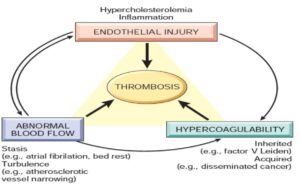Define thrombosis?
Thrombosis is a process of thrombus formation. A thrombus is an adherent intravascular coagulation (blood clot or solid mass of blood constituents) that develops in an intact circulatory system (artery/ vein or heart chambers).
Often causes significant interruption to blood flow. It is composed of varying proportions of coagulation factors, RBCs, and platelets.
Pathogenesis of thrombosis
3 primary influences predispose factors to thrombus formation, the so-called Virchow’s triad:
- Endothelial injury
- Stasis or turbulence of blood flow
- Blood hypercoagulability

Endothelial Injury
This is the dominant influence on thrombus formation. Endothelial injury is particularly important in thrombus formation in the heart (e.g. Myocardial infarction) and arterial circulation (vasculitis), atherosclerosis, hypertension.
Overt loss of endothelium exposes sub-endothelial extracellular matrix (ECM). Endothelium dysfunction. More procoagulant factors (e.g., platelet adhesion molecules, tissue factor, inhibitors of plasminogen activator (PAIs) or fewer anticoagulants effectors (e.g. thrombomodulin, PGI2, t-PA).
Abnormal blood flow
- Turbulence
- Arterial and cardiac thrombus formation and causes are hypertension and ulcerated atherosclerotic plaque in the vessel wall.
- Stasis
- Sluggish blood flow development of venous thrombus formation.
- Causes are myocardial infarction- areas of noncontractile myocardium and aortic or arterial aneurysm.
Endothelial cell activation resulting in increased prothrombotic activity. Normal laminar blood flow is disturbed which allows platelets and other cells to flow in the central column and peripheral slowly flowing plasma fluid layers separate platelets from endothelial contact. Stasis prevents the washout of activated clotting factors and inflow of clotting factor inhibitors.
Hypercoagulability
Any alteration of the coagulation pathways predisposes to thrombosis. There are two hypercoagulable states i.e. Primary (genetic) and Secondary (acquired).
The most common primary causes are
- Factor V mutation (factor V Leiden)
- Prothrombin mutation
- Increased levels of factors VIII, factors-IX, factors-XI, or fibrinogen
Rare primary causes are
- Antithrombin III deficiency
- Protein C deficiency
- Protein S deficiency
Secondary (acquired) causes
- Prolonged bed rest or immobilization
- Myocardial infarction
- Atrial fibrillation
- Tissue injury (surgery, fracture, burn)
- Cancer
- Heparin-induced thrombocytopenia
- Antiphospholipid antibody syndrome
- Hyperestrogenic states (pregnancy and postpartum)
Morphology
Gross
Size and shape depend upon the site of origin. Firmly adherent focally to the underlying vascular surface.
Cut section:
- Lines of Zahn- laminated dark and pale zones. These represent pale platelet & fibrin layers that alternating with darker red cell-rich layers.
- The lines of Zahn are only found in thrombi that form in flowing blood. The lines of Zahn helps to differentiate antemortem thrombus from postmortem thrombus.
Microscopy
The thrombus is composed of platelet, fibrin, RBCs, and WBCs. It is firmly adherent to the vessel wall. Lines of Zahn; Paler zone (platelet + fibrin) and the Darker zone are RBCs.
The fate of Thrombus (@PEDOR) thrombosis
- Propagation: The thrombus enlarges.
- Embolization: Some part or all of the thrombus is dislodged & transported elsewhere in the vasculature.
- Dissolution: If a thrombus is newly formed, & activation of fibrinolytic factors may lead to its rapid or quick shrinkage & complete dissolution.
- Organization and Recanalization: In the growth of endothelial cells, smooth muscle cells, and fibroblasts into the fibrin-rich thrombus. Capillary channels are formed.
[embeddoc url=”https://notesmed.com/wp-content/uploads/2021/05/Thrombosis.pdf” download=”all” text=”Complete pdf-Download”]